- Author: Patti C. Wooten Swanson
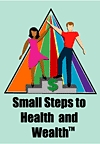
Why?
Reduce your risk of cardiovascular disease by reducing the total fat, saturated fat, and calories you consume in milk and dairy products.
Whole and reduced fat (2%) milk are among the top food sources of saturated fat in the U.S. diet.
What's in one 8 ounce serving of milk?
|
|
Total |
Saturated |
|
|
Whole milk |
8 |
5 |
152 |
|
Reduced fat (2%) |
5 |
3 |
122 |
|
Low-fat (1%) |
2 |
2 |
101 |
|
Fat-free (Nonfat/Skim) |
1 |
0 |
90 |
Source: Dairy Council of California
Look what happens when you switch from whole to low-fat milk:
• Reduce total fat from 8g to 2g
• Reduce saturated fat from 5g to 2g
• Reduce calories from 152 to 101
Try these strategies to make the switch work for you and your family.*
Swap, substitute, and shrink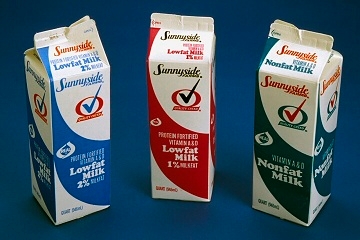
Substitute: 1% or nonfat milk in recipes and when preparing foods such as casseroles, soups, pudding, egg dishes, pancakes and waffles, or macaroni and cheese|
Shrink: Have a smaller glass of whole or reduced-fat milk or a smaller serving on your cereal, then make the rest of your dairy products low- or nonfat (yogurt, cheese, soy drinks)
Use the "step-down principle"
If you usually drink whole milk, make the switch gradually to give yourself time to adjust to the taste and texture differences.
_____Start with reduced fat (2%) milk
_____then switch to low-fat (1%) milk
_____and finally transition to fat-free (skim) milk.
Or, make the change more slowly.
If going from whole milk to 2% milk is too big of a jump, try mixing whole milk and 2% milk for a while. Once you've gotten used to that, switch over to 2% milk (only) and drink that until you are used to it.
Do the same when switching from 2% to 1% milk, and then from 1% to nonfat milk.
Tip: If you drink cappuccinos or lattes—ask for them with low-fat or fat-free (skim) milk.
* Children under 2 years should only drink whole milk, not reduced, low-fat or skim milk.
- Author: Patti C. Wooten Swanson

Now, when you take the San Diego Saves Pledge you can choose to receive text message tips and reminders...And if that isn’t enough, we are giving away $500 to help one person reach their savings goal. (Must be 18 years of age or older to win and standard text messaging rates apply.)
Enter to win the $500---here’s how:
1. Take the San Diego Saves Pledge between now and June 30, 2013
Choose a savings goal and choose an amount to save.
2. Click the box to receive text messages.
Get messages about your saving goal:
• Tips to help you find money to save
• Advice about saving
• Reminders to help you save for your specific goal
Share this with friends and family.
This may just what they need to set their own goal to:
• Start an emergency fund
• Pay down debt
• Save for education or retirement
It's a win-win!
One lucky person will win $500 to help them reach their saving goal---and everyone wins by staying motivated to save.
You won't get unwanted messages or marketing.
*San Diego Saves (SDS) is an educational program of the University of California Cooperative Extension program in San Diego County that is conducted in partnership with the Consumer Federation of America. The program seeks to motivate, encourage, and help families and individuals to save and build wealth for a secure financial future.
Good Luck and Happy Saving!
- Author: Patti C. Wooten Swanson
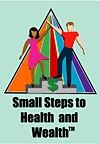
Make half your plate fruits and vegetables.
That’s the latest advice from USDA nutrition experts.
Why do I like this approach to healthy eating?
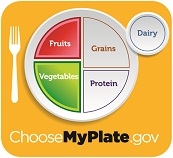
• It’s visual. A quick look at my plate tells me how well I am doing and I get positive feedback at every meal.
• It’s tasty and satisfying. Unlike diets that focus on limiting what I eat, this is a green light to fill up with foods that leave me full and satisfied after a meal.
What’s in it for me?
1. Fewer calories
Fruits and vegetables are low in calories (if prepared without added fats or sugar)
Cinnamon roll or fruit plate: Compare the calories: See how many fruits and vegetables you can eat in place of just one cinnamon roll.
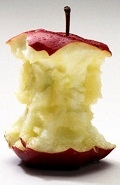
2. Important nutrients
Fruits and vegetables are good sources nutrients that we all need, such as magnesium, potassium, dietary fiber, and Vitamins A, C, and K.
3. Reduced risk of some chronic diseases
Eating at least 2 ½ cups of vegetables and fruits a day is associated with a reduced risk of cardiovascular disease, including heart attack and stroke. Some fruits and vegetables may protect against certain types of cancer.
Now that’s news we can use---starting at dinnertime tonight.

Learn how you can save money when buying fruits and vegetables.
- Author: Patti C. Wooten Swanson
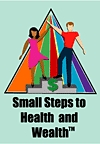
Small Step: Evaluate your homeowners insurance coverage.
If natural disaster destroyed your home, would your homeowners insurance policy pay enough to rebuild the house?
The recent fires and floods across the country started me thinking about my own financial preparation and ability to recover from a natural disaster. Like most Americans, my home is my largest financial asset and the cornerstone of my retirement plans.
It's makes financial sense to be sure my homeowners insurance policy will protect my investment if there is a natural disaster.
Three Questions to Ask About Your Homeowners Policy:

Policies generally cover either the “actual value” or the “replacement value” of a home. The names sound similar, but there can be a big difference in the coverage.
An “actual value" policy pays to rebuild the house based on its depreciated value. If you have an older home, the policy may pay considerably less than what it what it would cost to rebuild today using new materials.
For example, my house (built in the 1950s) has a 20 year old roof. If a fire destroyed the house an "actual value" policy would pay the depreciated value of the roof, which would not be nearly enough to replace it at today's prices. The same goes for replacing older bathroom fixtures and worn kitchen floor coverings.
In contrast, a replacement value" policy would cover the full cost (less a deductible) to rebuild at current prices.
2. Do you have enough insurance coverage?
First, read your home owners policy to find out the dollar value of your coverage.
How do you know if you have enough? Get a rough estimate of what it would cost to rebuild your home by asking a local builder or contractor the cost per square foot for new construction (labor and materials) and multiply the cost by the total square footage of your house.

Don't base the amount of insurance on the market value of your home. If you do, you'll buy more insurance than you need, since that price includes the value of the land your home is on. Most likely, the land will still be useable after a natural disaster, so you only need to insure the structure.
Be sure to update the policy value if you do a substantial renovation or make an addition to the house.
3. Does the policy cover the disasters you are likely to face?
Review the policy document to find out. Standard homeowner policies, known as HO-3 policies, cover specified disasters or "perils" which are listed in the written policy: fire, lightning, tornadoes, wind storms, hail, explosions, smoke, vandalism and theft. Most do NOT cover damage caused by floods and earthquakes.

Visit FEMA's National Flood Insurance Program (NFIP) website to learn more. If you live in a moderate-to-low risk area and are eligible for the Preferred Risk Policy (low cost), your flood insurance premium could be as low as $129 a year.
If you live in a flood prone area, contact your insurance agent or go to your State Insurance Commission's website to find out about costs and purchasing flood insurance.

You can buy a supplemental policy that covers earthquakes from an insurance agent. Californians may contact the California Earthquake Authority (CEA), a publicly managed organization that provides catastrophic residential earthquake insurance.
Financial Planning Tip: Homeowners insurance is an important part of a financial plan. Plan to be covered!
- Author: Patti C. Wooten Swanson
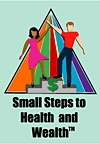
Small step: Pay for groceries with cash, not credit.
Does grocery shopping for healthy food sometimes feel like walking through a minefield?
It does to me!
Temptations are everywhere---cookies, cakes, and ice cream, oh my!
I go to the store with a detailed grocery list, determined to make healthful choices and avoid high fat, high sugar, high calorie foods.
But marketers are clever and there are hazards everywhere I turn:
- A beautiful red velvet cakes bring back childhood memories
- The smell of freshly baked French bread coming out of the oven as I shop calls me to take some home
- In-store samples of the zebra popcorn (coated with chocolate and caramel) melt my sales resistance
New Research Findings 
It's possible to change shopping
behavior to limit unhealthy food
purchases by paying cash for groceries.
A study reported in the Journal of Consumer Research* found that consumers who paid cash took home healthier foods than thos who paid with a credit card.
Researchers analyzed the shopping behavior of 1,000 households over six months to learn what they bought and how they paid for it. Their investigation was based on 2 concepts from behavioral economics: impulsive consumption, and psychological effects of different payment methods.
Impulsive consumption
Impulse buys are purchases made on the spur of the moment without any forethought or planning.
Grocery stores are designed to promote impulsive consumption. It's no mistake when shoppers have to pass by the bakery (with its cakes, pies, and cookies) and the deli (with its savory roasting chickens) in order to get to the meat, eggs and dairy products at the back of the store. Or, go past the big displays of chips and soft drinks to reach the checkout.
Payment method
So how does the way we pay for our groceries influence whether or not we buy unhealthy foods? 
It’s because paying with a credit card "feels" different than paying with cash. Using a credit card is relatively “painless” since the purchase is separated in time from actual payment. But handing over hard cash is a different matter, it's painful.
In other words, it’s easier to buy junk food with credit because we don’t feel the pain of putting actual dollars on the counter!
What YOU Can Do
When the cashier asks “Paper or plastic?” pull out cash rather than your credit card to pay for the groceries, and take home healthier foods.
Tip: Rodale author Emily Main suggests you go by the ATM and get cash before you go to the grocery store, and don't forget to bring a shopping list along, too.
How credit card payments increase unhealthy food purchases




